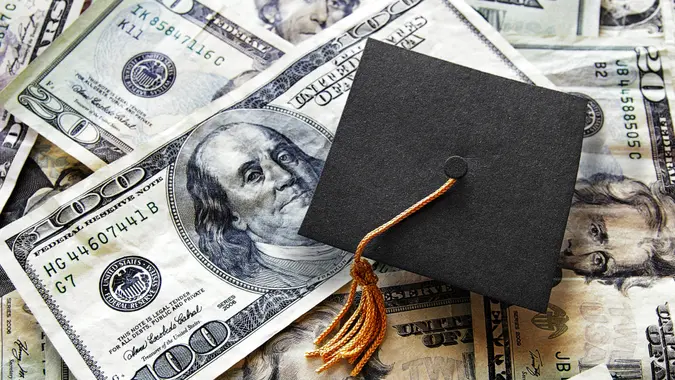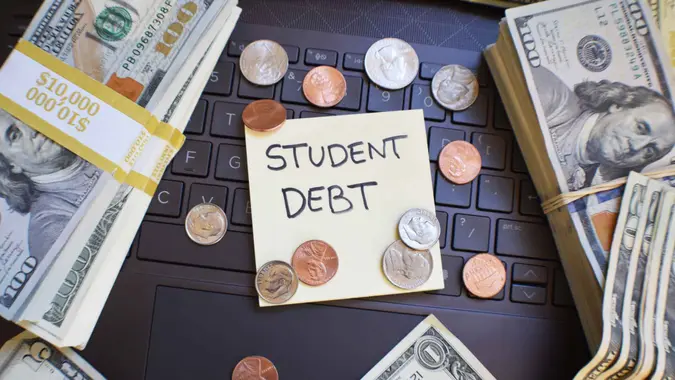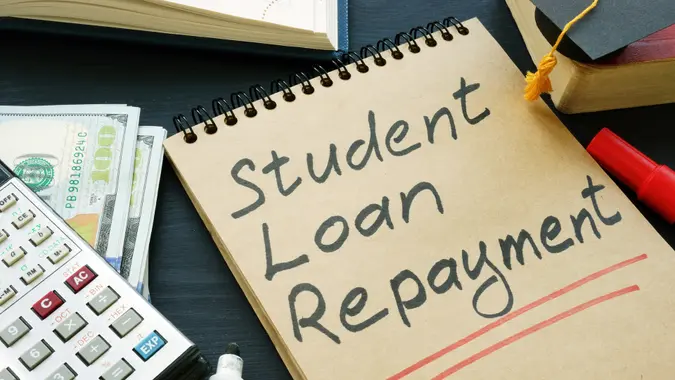Student Loan Forgiveness Programs 2025: Who’s Eligible and How To Apply

Commitment to Our Readers
GOBankingRates' editorial team is committed to bringing you unbiased reviews and information. We use data-driven methodologies to evaluate financial products and services - our reviews and ratings are not influenced by advertisers. You can read more about our editorial guidelines and our products and services review methodology.

20 Years
Helping You Live Richer

Reviewed
by Experts

Trusted by
Millions of Readers
The total U.S. student loan debt is nearly $1.8 trillion, according to the Education Data Initiative. This breaks down to an estimated $41,618 in total average student loan debt.
If you have student loan debt, student loan forgiveness programs could help. If you qualify, student loan forgiveness could eliminate any remaining debt you owe — after a certain point. Notably, these programs primarily work for federal student loans. Private student loans generally don’t qualify.
Types of Student Loan Forgiveness Programs
Student loan forgiveness opportunities are out there, so if you’re struggling with debt, know that you have options. These are some of the biggest student loan forgiveness programs today, and how to qualify.
Public Service Loan Forgiveness
The Public Service Loan Forgiveness program, or PSLF, is geared toward government or not-for-profit workers. If you qualify, you could get the remaining balance on Direct Loans forgiven.
To be eligible, the borrower must:
- Be a government worker, teacher or non-profit employee
- Have made 120 qualifying monthly payments (or 10 years).
- Repayments must be made under either a 10-year Standard Repayment Plan or as part of an income-driven repayment plan
- Be working full-time for an eligible employer
- Have Direct Subsidized Loans, Direct Unsubsidized Loans, Direct PLUS Loans or Direct Consolidation Loans
You can use the PSLF Help Tool to apply for this program. You’ll need to certify your employment using your most recent W-2 or your employer’s Federal Employer Identification Number.
Note: A federal court-issued injunction currently prevents the U.S. Department of Education from implementing certain student loan forgiveness programs — including the SAVE Plan and certain parts of income-driven repayment plans. This has made the online application process for certain programs temporarily unavailable.
Income-Driven Repayment (IDR) Forgiveness
Getting on an income-driven repayment (IDR) plan is one of the best methods of having your federal student loans forgiven. There are four IDR plans:
- Pay As You Earn (PAYE) Repayment Plan
- Saving on a Valuable Education (SAVE) Plan — formerly the “REPAYE Plan”
- Income-Based Repayment (IBR) Plan
- Income-Contingent Repayment (ICR) Plan
IDR plans have multiple benefits for student loan borrowers, including:
- Lower monthly payments: Your payment amount is typically based on a percentage of your income. For some plans (including the SAVE and ICR plan), payment size is determined by your income and family size. Payment could be as low as $0.
- Specific timeline: These plans take between 20 and 25 years, at which time any remaining balance will be forgiven. The borrower must make consistent payments for this to happen.
- Multiple loan types: Loans eligible for forgiveness include Direct Subsidized Loans, Direct Unsubsidized Loans and Direct PLUS Loans made to professional students. Certain loans require a specific income-driven repayment plan.
The online application for an IDR plan and online loan consolidation is temporarily suspended. However, new applicants can submit a paper loan consolidation application.
Teacher Loan Forgiveness
Teachers may receive student loan forgiveness of $5,000 to $17,500. The following loan types qualify:
- Direct Subsidized Loans
- Direct Unsubsidized Loans
- Subsidized Federal Stafford Loans
- Unsubsidized Federal Stafford Loans
Be aware that you won’t receive credit for the PSLF program and the TLF program at the same time. To receive benefits for PSLF, you must make 120 more qualifying monthly payments that weren’t part of TLF.
Other eligibility criteria for the Teacher Loan Forgiveness Program include:
- You must not have an outstanding balance on Direct Loans or with a Federal Family Education Loan Program (as of October 1, 1998).
- You must be a full-time employed, highly qualified teacher for five consecutive years after 1997-98.
- The school you work at must be an elementary school, secondary school or educational service agency that directly serves low-income students.
- You must have taken out the student loans before the end of your 5 academic years of qualifying service.
You can apply for this program by filling out and submitting a Teacher Loan Forgiveness Application online. Submit the completed application to your loan servicer, but only after completing 5 consecutive years of teaching. The Chief Administrative Officer of your school or educational service agency must complete the certification section. Submit separate applications to each loan servicer.
Note: If you want to find out if you teach at a low-income school, you can check the Teacher Cancellation Low Income (TCLI) Directory database.
Other Federal Loan Forgiveness Programs
Other federal student loan forgiveness opportunities exist as well, including:
- Disability-based forgiveness: If you’re totally and permanently disabled and you have a Direct Loan, a Federal Family Education Loan Program Loan or a Perkins Loan, you may qualify for forgiveness.
- Federal Perkins Loan cancellation: Eligible borrowers in the teacher/education industry could get up to 100% of their Perkins Loan canceled. Loans can be canceled in 15%, 20% or 30% increments (based on years of service).
- Military service loan forgiveness: If you’re active duty (U.S. military), you could be eligible for up to 50% of loan cancellation (if service ended before August 14, 2008) or 100% cancellation (if service began on August 14. 2008).
- State-specific loan forgiveness options: There are some state-specific student loan forgiveness opportunities. For example, the Massachusetts Loan Repayment Program had a program for eligible healthcare workers (available through February 10, 2025). Check your state for other options.
- Other niche forgiveness opportunities: If your school closed either while you were enrolled or shortly after leaving, you may qualify for loan discharge (the removal of your debt obligation). If the student loan borrower is a victim of forgery, declares bankruptcy or passes away, their debt may also be forgiven.
| Program | Eligibility Criteria | Repayment Term Before Forgiveness | Maximum Forgiveness Amount | Best For | Key Considerations |
|---|---|---|---|---|---|
| Public Service Loan Forgiveness (PSLF) | Full-time employment in government or qualifying nonprofit | 120 qualifying monthly payments (10 years) | Remaining loan balance | Government and nonprofit workers | Requires Direct Loans and income-driven repayment; strict documentation needed |
| Income-Driven Repayment (IDR) Forgiveness | Enrollment in an IDR plan (PAYE, REPAYE, IBR or ICR) | 20-25 years of payments | Remaining balance after repayment period | Borrowers with high debt-to-income ratio or limited income | Forgiven balance may be taxed as income (except under current temporary relief) |
| Teacher Loan Forgiveness | Five consecutive years at a low-income school | 5 years | Up to $17,500 | Teachers in high-need subjects | Cannot be combined with PSLF; must meet subject area requirements |
| Perkins Loan Cancellation | Teachers, nurses, law enforcement, public service workers | 5 years | Up to 100% of loan | Perkins Loan borrowers in qualifying professions | Program is being phased out; limited eligibility |
| Military Service Forgiveness | Active-duty service members in eligible branches | Varies by service and loan type | Partial or full forgiveness | Military personnel | Specific programs apply to different branches and loan types |
| State-Sponsored Loan Forgiveness | Varies by state and profession | Varies | Varies by program | Teachers, healthcare workers, public defenders | State-specific; may require long-term in-state service |
Who Qualifies for Student Loan Forgiveness?
Not everyone qualifies for student loan forgiveness programs (but many borrowers do). These are key factors that determine eligibility:
- Length of repayment: For some programs, you must be on an income-based repayment plan. You must also have been consistently paying off your loans for a set period (generally 20 to 25 years).
- Loan type: Forgiveness programs are primarily geared toward federal loans (not private). This includes Direct Subsidized Loans, Direct Unsubsidized Loans, Direct PLUS Loans and Direct Consolidation Loans.
- Type of employment: You may need to work in a specific industry to qualify for student loan forgiveness, such as education or healthcare. Government, nonprofit and military personnel may also qualify.
How To Apply for Student Loan Forgiveness
If you’re ready to apply for student loan forgiveness, here’s how to do it:
- Find the right program. Compare different programs to see what’s available and their requirements.
- Gather your documents. You’ll need certain documents, depending on the program. For example, the PSLF program requires a document certifying your employment. Other documents verifying your full-time employment status (like W-2s or pay stubs) can also help.
- Complete the application. You may be able to apply online, but some programs require a mailed-in application.
- Check your application status. You can do this by logging into StudentAid.gov and clicking “View All Activity.” Alternatively, speak with your loan servicer to see your progress toward forgiveness.
Alternatives If You Don’t Qualify for Forgiveness
Even if you don’t qualify for student loan forgiveness programs, there are other ways to get help with your debt, including:
- Loan consolidation: This lets you combine multiple federal student loans into a single loan with one monthly payment. It won’t forgive your debt entirely, but it could mean lower monthly payments. Certain loan consolidation options could still qualify for forgiveness over time.
- Refinancing: If you have private student loans and good credit, refinancing them could get you lower interest rates. Refinancing typically disqualifies any loans for future forgiveness.
- Deferment: This lets you put off making payments for a short period (usually because of financial hardship). Since you’re not making payments, you’re extending how long you have debt. However, some loans will not incur interest during deferment.
- Forbearance: If you have a qualifying reason (like financial hardship), you may put your loans in forbearance. This is a temporary payment pause. Interest will continue to accrue on the unpaid balance.
FAQ
- How long does it take to get student loan forgiveness?
-
- It depends on the program, but it can take between 20 and 25 years on an income-driven repayment plan. Some programs, like the PSLF, require 120 consecutive payments (or 10 years).
- Can private student loans be forgiven?
-
- Student loan forgiveness programs are geared toward federal student loans. Most private student loans do not qualify for forgiveness, but you can speak with your lender about any deferment, forbearance or refinancing options.
- Does student loan forgiveness impact credit scores?
-
- Your FICO credit score consists of many factors, including credit mix. Credit mix constitutes 10% of your overall score. Paying off your student loans -- or having them forgiven -- could lessen your credit mix and cause your credit score to drop slightly.
- Are there tax implications for forgiven student loans?
- Forgiven student loans aren't generally considered taxable income, meaning you won't have to pay taxes on them. It's still a good idea to confirm the tax implications -- if any -- when pursuing student loan forgiveness opportunities.
- What happens if I switch jobs before getting forgiveness?
- It depends on the program. Take the Public Service Loan Forgiveness program. You must work full-time for a qualifying employer when you make your 120 qualifying payments, as well as when you apply -- and receive -- loan forgiveness.
Our in-house research team and on-site financial experts work together to create content that’s accurate, impartial, and up to date. We fact-check every single statistic, quote and fact using trusted primary resources to make sure the information we provide is correct. You can learn more about GOBankingRates’ processes and standards in our editorial policy.
- Education Data Initiative "Student Loan Debt Statistics"
- Federal Student Aid "SAVE Plan Court Actions: Impact on Borrowers"
- Federal Student Aid "Income-Driven Repayment Plans"
- Federal Student Aid "Teacher Loan Forgiveness"
- Federal Student Aid "Total and Permanent Disability Discharge"
- Federal Student Aid "Federal Perkins Loan Cancellation and Discharge"
- Federal Student Aid "Public Service Loan Forgiveness (PSLF)"
- Massachusetts Loan Repayment Program "Student Loan Relief for Providers"
- Federal Student Aid "Closed School Discharge"
- Federal Student Aid "Student Loan Forgiveness"
- Federal Student Aid "Consolidating Student Loans"
- Federal Student Aid "Student Loan Deferment"
- Federal Student Aid "Student Loan Forbearance"
- Federal Student Aid "Am I still eligible for Public Service Loan Forgiveness (PSLF) if I make my last qualifying payment while working for a qualifying employer, but then leave that job to work for a for-profit corporation before applying for the PSLF benefit?"
 Written by
Written by  Edited by
Edited by 























